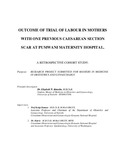| dc.contributor.author | Kimotho, Elizabeth W | |
| dc.date.accessioned | 2013-05-23T08:30:37Z | |
| dc.date.available | 2013-05-23T08:30:37Z | |
| dc.date.issued | 2009 | |
| dc.identifier.citation | Masters in medicine In obstetrics and gynaecology | en |
| dc.identifier.uri | http://erepository.uonbi.ac.ke:8080/xmlui/handle/11295/24689 | |
| dc.description.abstract | Although introduction of lower transverse uterine incision for caesarean section has remarkably
reduced the risk of uterine rupture during trial of labour (TOL), a consensus has not been reached
on universal TOL for women with 1 previous caesarean section delivery. There is also no
objective criterion for selecting patients for TOL with high predictive value for success.
Occasional severe maternal and foetal outcomes in TOL (especially when carried out in less than
ideal situations) are a deterrent to practise of TOL. The lack of data that provides indubitable
evidence on benefits accrued by TOL contributes towards low rates ofTOL.
Objective
To determine the pregnancy outcomes in patients with one previous caesarean section scar
undergoing trial of labour compared to those undergoing elective repeat caesarean section.
Design •
Retrospective cohort study whereby one group of patients undergo TOL and the second group
undergo ERCS.
Outcome measures
Maternal morbidity was assessed primarily based on postnatal hospital stay. Other maternal
morbidity measures ana lysed included infection, birth trauma and haemorrhage. Foetal outcome
was accessed based on APGAR score at five minutes and admission to the new born unit (NBU).
Setting
Postnatal wards in Pumwani maternity hospital (PMH).
Materials and Methods
The study compared maternal and foetal outcomes among women designated for trail of labour
and elective repeat caesarean section.
10
Results
Success rate ofTOL was low at 45.5%. There was no significant difference in socio demographic
characteristics between the TOL and the ERCS groups of the study (p-value >0.05). Duration of
maternal postnatal hospitalization was higher in the ERCS group with 51% of the participants
staying ~4days as compared with the TOL group where 29% had a similar stay (p-value 0.001).
Foetal outcome based on the APGAR score at 5 minutes was significantly better in the ERCS
group with 96.6% having a score of'> 8 as compared to 77.7% in the TOL group (p-value <0.001).
Admission to NBU and neonatal mortality was less in the ERCS group whereby 13.5% needed
admission with a mortality rate of 1% only. This is in comparison to the TOL group whereby 35%
were admitted to NBU with mortality at 3.7%.
Conclusion
Success of TOL was low necessitating emergency caesarean delivery in more than half of the •
women. Among these women undergoing EMCS, both maternal and foetal complication rates are
higher in comparison to those undergoing ERCS.
Recommendations
There is need to consider ERCS for patients with 1 previous scar in institutions which do not meet
the criteria for TOL whereby there is no proper monitoring of both maternal and foetal condition
during labour.
Recommend further studies to look into objective criteria which can be used in decision making
for trial of labour that will have an impact in the pregnancy outcome.
11 | en |
| dc.language.iso | en | en |
| dc.publisher | University Of Nairobi | en |
| dc.title | Outcome of trial of labour in mothers With one previous caesarean section Scar at pumwani maternity hospital | en |
| dc.type | Thesis | en |
| dc.description.department | a
Department of Psychiatry, University of Nairobi, ; bDepartment of Mental Health, School of Medicine,
Moi University, Eldoret, Kenya | |
| local.publisher | College of Health Sciences | en |

